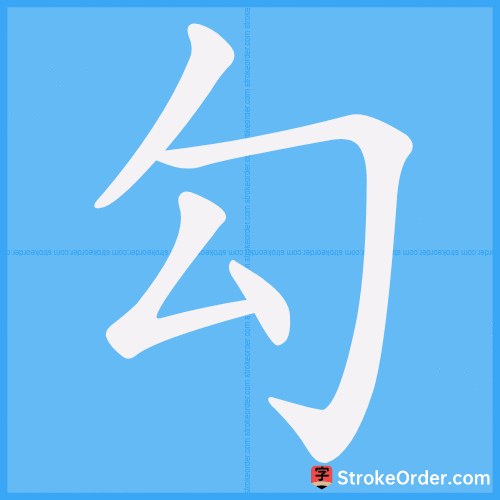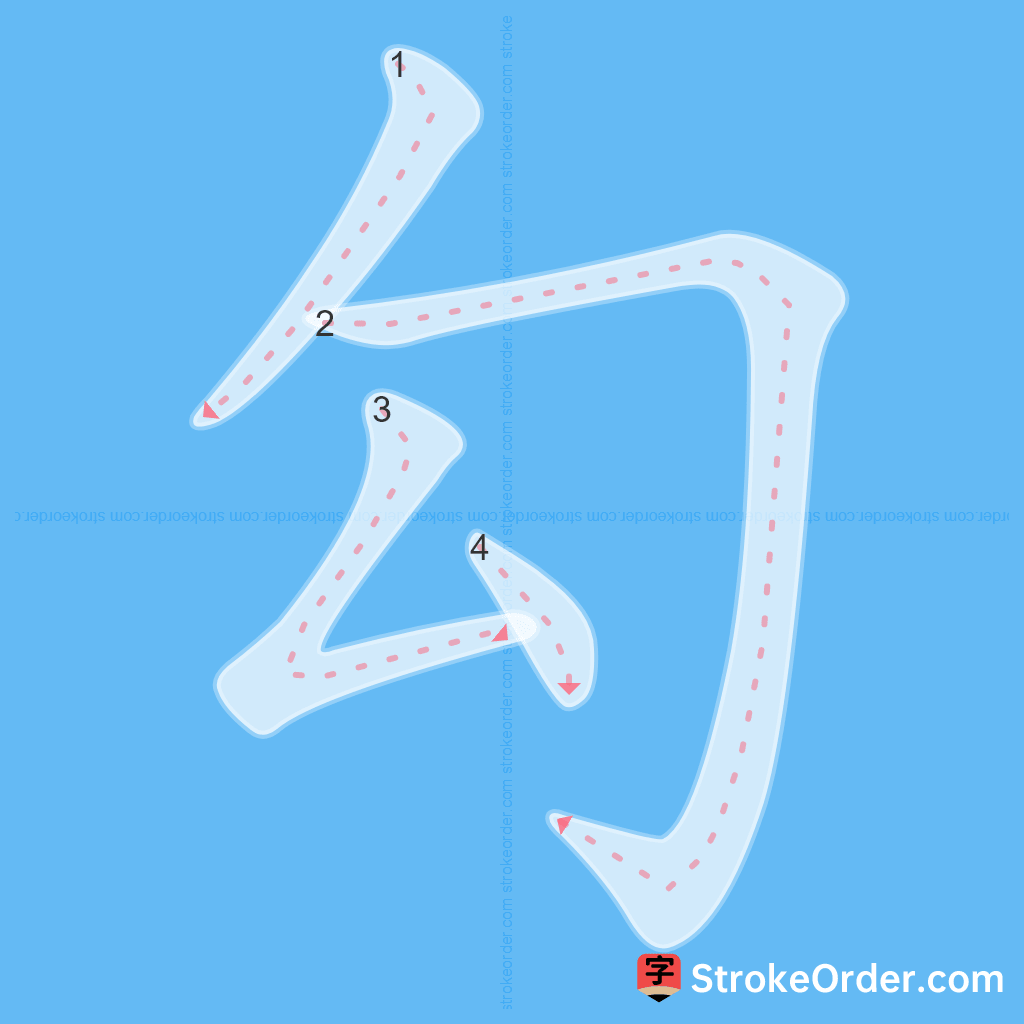勾 Stroke Order
Animated Stroke Order of 勾

Stroke Order Diagrams for 勾

Step-by-Step Handwriting Guide for 勾

Learn to Write Chinese Characters with Video Tutorials
Watch the video of writing the Chinese character "勾", learn the correct stroke order (笔顺) of the character "勾", and master the standard way of writing the character "勾".
Free Printable Handwriting Practice with Stroke Order: 勾
Printable Writing Practice Worksheet of "勾" in Portrait Orientation (Tian Zi Ge)

Printable Writing Practice Worksheet of "勾" in Landscape Orientation (Tian Zi Ge)

Information of 勾
Pinyin
gōu、 gòu
Radical
勹
Strokes
4 strokes
Usage
★★★★★
Definition
to cancel / to delineate / hook, affair / to reach for (with hand)
勾 [gōu]
1. To draw a symbol with a pen, indicating deletion or extraction.
2. To outline an image or depict.
3. To smear seams of buildings with materials such as ash or cement.
4. To blend and thicken, to season.
5. To pull or attract.
6. To linger or stay.
7. To absorb.
8. In ancient Chinese mathematical texts, referred to the shorter leg of an isosceles right triangle.
勾 [gōu]
1. To draw a symbol with a pen, indicating deletion or extraction: 勾销 (cancel). 勾乙 (marking certain words or phrases in publications with a symbol resembling "乙" to indicate as material).
2. To outline an image or depict: 勾画 (delineate). 勾勒 (sketch).
3. To smear seams of buildings: 勾缝 (caulk joints).
4. To blend and thicken, to season: 勾芡 (thicken for sauce).
5. To pull or attract: 勾引 (entice). 勾通 (draw in).
6. To linger or stay: 勾留 (detain).
7. To absorb: 勾魂摄魄 (to mesmerize or captivate).
8. In ancient Chinese mathematical texts, referred to the shorter leg of an isosceles right triangle: 勾股定理 (Pythagorean theorem).
勾 [gōu]
(verb)
1. Originally written as “句”, meaning bend.
2. To delete or extract.
3. To delineate (to outline a contour with a pen).
4. To collude with.
5. To seduce or entice.
6. To catch or arrest.
7. To thicken or blend.
8. To obtain or gain.
勾 [gōu]
(noun)
1. In ancient times, referred to the shorter leg of a right triangle.
2. See gòu.
勾 [gòu]
(noun)
1. A trap (【English】: trap). For example, 勾中 (fall into a trap).
勾 [gòu]
(adjective)
1. Same as “够”. Sufficient; able.
2. See gōu.
to draw the outline of / to outline / to sketch / to delineate contours of / to give a brief account of
to fight and scheme against each other (idiom) / (in palace construction) elaborate and refined
to be linked together / to be involved with / to collude / interconnection / involvement / collusion
Input Method for 勾
Pinyin
gou1
Wubi
qci
Cangjie
pi
Zhengma
ryzs
Four Corner
27720
Unicode
U+52fe
Same Pronunciation Characters